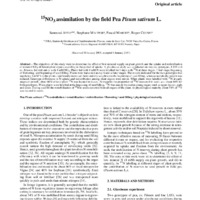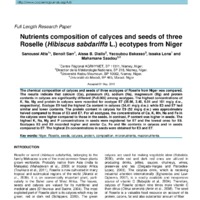Recherche
3 items
15NO3 assimilation by the field Pea Pisum sativum L.
Abstract – The objectives of this study were to determine the effect of low mineral supply on plant growth and the uptake and redistribution of mineral N by different plant organs according to the period of uptake. A glasshouse study was conducted on two pea genotypes, L833 and cv. Frisson, fed without or with 4 mM NO3. Plants fed with 4 mM N were labelled for 5 days with 15N at three stages: 7 leaf stage, beginning of flowering, and beginning of seed filling. Plants were harvested at day 6 and at later stages. The results indicated for the two genotypes that supplying 4 mM N to the plants significantly increased their total dry weight up to the beginning of seed filling, whereas nodule dry weight was reduced. Genotype differences in N uptake and redistribution among plant organs were minor. When plants were labelled with 15N at early stages of growth, about 60& of total plant 15N was located in leaves. At maturity the proportion of 15N recovered in seeds was about 60& for both genotypes. When plants were labelled at the beginning of seed filling, 15N was mainly located in young organs such as upper leaves, pods and seeds. During seed fill the remobilisation of 15N to seeds occurred from all organs of the plant. At physiological maturity about 70& of 15N was located in seeds.
ANNUAIRE DES DIPLOMES 1975 - 2016
Le Centre Régional AGRHYMET (CRA), institution spécialisée du Comité permanent Inter-Etats de Lutte contre la Sécheresse dans le Sahel (CILSS) s’est distingué au niveau national et international par la pertinence et la fiabilité des informations agropastorales qu’il met à la disposition des décideurs politiques nationaux et des partenaires, mais également par le renforcement des capacités de conception et d’exécution des cadres africains à travers des formations professionnelles de référence adaptées au contexte sahélien et ouest africain. Depuis sa création, le CRA a formé 1341 diplômés dont 805 Techniciens Supérieurs, 250 Ingénieurs, et 286 Masters dans les domaines de la Sécurité Alimentaire, Gestion des Ressources Naturelles et Maîtrise de l’Eau dans un contexte de changement climatique. Il a également participé au perfectionnement de plus de 9000 cadres sahéliens et ressortissants d’autres régions d’Afrique. Le succès de ces formations constitue un réel motif de satisfaction pour le CILSS et ses partenaires, surtout que la demande de cette prestation dépasse l’espace sahélien pour toucher désormais d’autres pays de la CEDEAO et de l’Afrique Centrale et Australe. La qualité de ses enseignements a valu au CRA les reconnaissances suivantes : − Centre d’Enseignement Supérieur du CAMES (Conseil Africain et Malgache pour l’Enseignement Supérieur), − Centre d’Excellence Régionale en matière de formation de l’UEMOA (Union Economique et Monétaire Ouest Africaine), − Centre Régional de Formation de l’OMM (Organisation Météorologique Mondiale), − Membre titulaire de l’AUF (Agence Universitaire de la Francophonie) Le présent annuaire réactualisé répond au souci de fournir des renseignements détaillés et précis sur les diplômés formés par le CRA de 1975 à 2016 ainsi qu’aux attentes des décideurs et des bénéficiaires potentiels. Il récapitule par pays, par cycle et par promotion, les personnes formées. Il fournit entre autres, des informations sur les services employeurs des diplômés ainsi qu’une description succincte des tâches qui leur sont confiées sur le terrain. Nous osons espérer qu’il sera apprécié à sa juste valeur.
Nutrients composition of calyces and seeds of three Roselle (Hibiscus sabdariffa L.) ecotypes from Niger
The chemical composition of calyces and seeds of three ecotypes of Roselle from Niger was compared. The results indicate that calcium (Ca), potassium (K), sodium (Na), magnesium (Mg) and protein contents in calyces are significantly different (P<0.005) among ecotypes. The highest concentrations of K, Na, Mg and protein in calyces were recorded for ecotype E7 (35.66, 3.40, 6.01 and 101 mg/g d.w., respectively). Ecotype E9 had the highest Ca content in calyces (34.41 mg/g d.w.); while E3 and E7 had similar and lower contents. The protein content in calyces for E9 (52 mg/g d.w.) was approximately halved compared to those of E3 and E7. For all ecotypes, the concentrations of Ca, K, Mn, Na and Fe in the calyces were higher compared to those in the seeds. In contrast, P content was higher in seeds. The highest K, Na, Mg and P concentrations in seeds were registered for E7 and the lowest ones for E9. Ecotypes E3 and E9 recorded higher and similar Cu, Fe and Mn contents in calyces and in seeds compared to E7. The highest Zn concentrations in seeds were obtained for E3 and E7.


